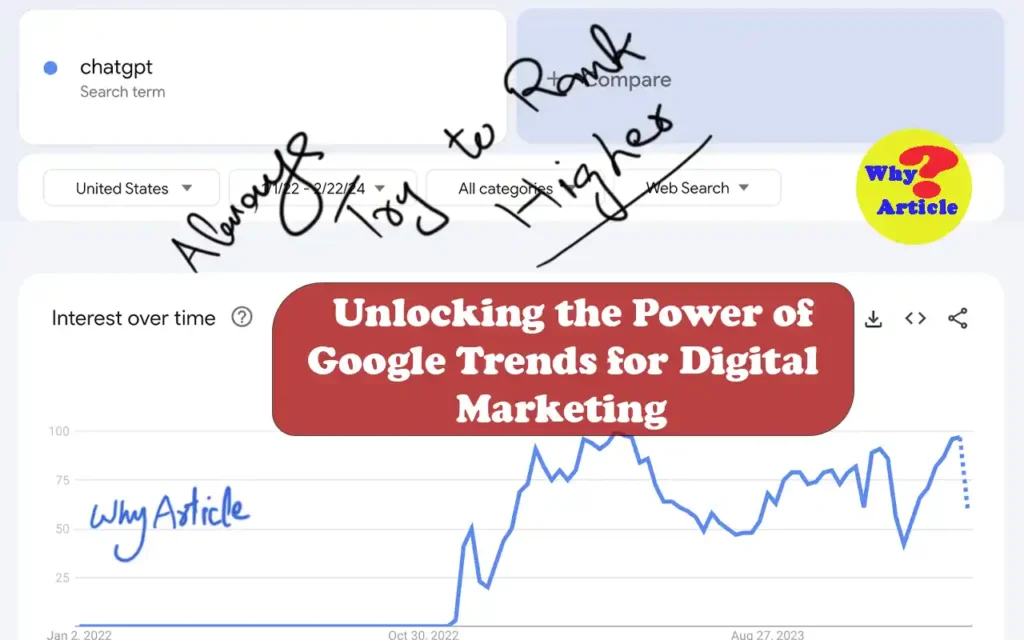
In the fast-paced world of digital marketing, staying ahead of the competition can feel like a daunting task. Luckily, tools like Google Trends make it easier than ever to gain insights into what your audience is searching for and how you can leverage that information to your marketing strategies.
Google Trends offers valuable data on search behaviors, allowing you to make informed decisions about your business. In this article, we’ll explore how to use Google Trends for digital marketing effectively to boost your marketing game.
Why Use Google Trends?
Google Trends is an incredible tool that helps you understand what people are searching for online. It’s like having a crystal ball for consumer behavior!
You can do competitor analysis using Google Trends. By analyzing search data, you can identify trends over time, discover related topics, and even uncover seasonal demand for products or services.
This way, you can tailor your marketing strategies to align with what potential customers are interested in right now.
Benefits of Using Google Trends
- Competitive Analysis: Learn how you stack up against competitors.
- Brand Awareness: Gauge public perception of your brand.
- Demand Forecasting: Predict what products or services might be in demand soon.
How to Benchmark Against Competitors
Step 1: Setting Up Your Comparison
The first thing you want to do is compare your brand with your competitors. To start, go to Google Trends and enter your company name in one panel. Then, enter a competitor’s name in another panel.
This gives you a clear visual representation of how your search interest compares.
- Choose Your Categories: Select a category relevant to your industry. This helps narrow down the data to ensure you’re looking at the most relevant search terms. If you can’t find a fitting category, that’s okay—sometimes, broader comparisons can still provide valuable insights.
Step 2: Analyzing Search Trends Over Time
Once you have your competitors set up, you’ll see a trend line that shows how often people are searching for each brand over time.
This line will indicate whether your brand is gaining traction, losing interest, or holding steady.
- Look for Spikes: Spikes in the trend line can indicate successful marketing campaigns or seasonal interest in certain products. Pay attention to these trends, as they can guide your future marketing efforts.
Step 3: Understanding Regional Interest
Google Trends allows you to dive deeper by looking at specific regions where interest in your brand or product is highest.
Scroll down to the subregion section to get a better idea of where your marketing efforts should be concentrated.
- Target Your Marketing: If you find that certain areas show a lot of interest in your product, consider focusing your marketing efforts in those regions. This could involve localized ad campaigns, events, or even deciding where to open a new store.
Analyzing Brand Awareness
Step 1: Monitoring Brand Perception
Google Trends can also help you keep tabs on how your brand is perceived in the marketplace.
To do this, set the time range for the past 30 or 90 days to see how the public’s interest in your brand has changed.
- Check Related Search Terms: Look at the related search terms that are rising or trending. These terms can give you insight into what people are associating with your brand. For instance, if people are frequently searching for “eco-friendly products” along with your brand name, it may be beneficial to emphasize your sustainability efforts in marketing.
Step 2: Exploring YouTube Search Trends
Don’t forget about YouTube! With more people using video content to learn about products, it’s essential to analyze search trends on this platform too.
By selecting “YouTube Search” from the categories dropdown menu in Google Trends, you can see how your brand stacks up in video searches.
- Visual Content Strategy: If you notice high search interest in video content related to your brand, it may be time to ramp up your video marketing efforts. Create tutorials, product demonstrations, or customer testimonials to meet that demand.
Forecasting Product Demand
Step 1: Identifying Seasonal Trends
One of the easiest ways to forecast product demand is to examine search terms over time.
For example, if you sell seasonal items like winter jackets or summer swimsuits, look for trends that show how interest in these products changes with the seasons.
- Plan Your Inventory: If you notice a spike in searches for “beachwear” during the summer months, it’s a good indication that you should stock up on those items ahead of time. This proactive approach can save you from missing out on potential sales.
Step 2: Discovering Related Products
In addition to tracking your primary products, don’t forget to explore related terms. By scrolling down on Google Trends, you can find “related topics” and “related queries.”
These can provide insight into other products that consumers are interested in at the same time.
- Diversify Your Offerings: If a related product, like “charcuterie boards,” is gaining interest alongside “cheese,” it may be worth considering expanding your inventory to include these trending items. Being aware of what’s popular can help you stay competitive.
Making Google Trends Work for You
Google Trends is more than just a tool; it’s a treasure trove of insights that can drive your digital marketing strategy.
By understanding how to use it effectively, you can make informed decisions that increase your brand visibility, enhance customer engagement, and ultimately boost sales.
Additional Tips for Success
- Regular Monitoring: Make checking Google Trends a regular part of your marketing routine. This helps you stay updated on the latest shifts in consumer interest.
- Combine with Other Tools: While Google Trends is powerful on its own, combining it with other tools like Google Analytics can give you a more complete picture of your audience’s behavior.
- Engage Your Audience: Use the insights gained from Google Trends to create content that resonates with your audience. Whether it’s blog posts, social media updates, or email newsletters, align your messaging with what your customers are searching for.
Frequently Asked Questions
What is Google Trends?
Google Trends is a free tool that shows how often specific search terms are entered into Google over time. It helps marketers understand consumer interest and behavior.
How can I use Google Trends to improve my marketing strategy?
By analyzing search trends, you can benchmark against competitors, brand awareness tracking and forecast product demand to inform your marketing decisions.
Is Google Trends only useful for online marketing?
No, Google Trends can be beneficial for both online and offline marketing strategies, as it provides insights into consumer behavior that can be applied to any marketing efforts.
How often should I check Google Trends?
It’s a good practice to check Google Trends regularly—ideally, at least once a month—to stay updated on changes in consumer interests and market dynamics.
Can I analyze YouTube search trends with Google Trends?
Yes! You can use Google Trends to explore search interest specifically for YouTube, helping you understand video content trends related to your brand.
Conclusion
Using Google Trends effectively can empower your digital marketing strategies. By leveraging its insights on competitor analysis, brand awareness and product demand forecasting, you can make data-driven decisions that keep you ahead of the competition.
Whether you’re a small business owner or part of a larger marketing team, integrating Google Trends into your strategy can provide you with the edge you need in today’s fast-moving digital landscape.
Happy marketing!




Your blog is a shining example of excellence in content creation. I’m continually impressed by the depth of your knowledge and the clarity of your writing. Thank you for all that you do.
Your blog is a true hidden gem on the internet. Your thoughtful analysis and engaging writing style set you apart from the crowd. Keep up the excellent work!